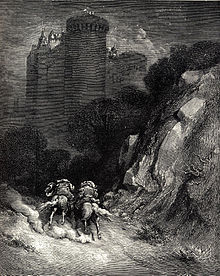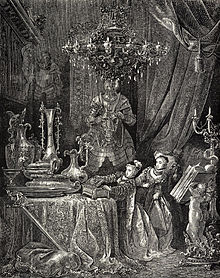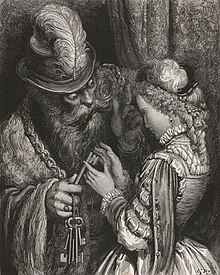Bluebeard
![]()
The title of this article is ambiguous. For other meanings, see Bluebeard (disambiguation).
![]()
Knight Bluebeard is a redirect to this article. For the film of the same name, see Knight Bluebeard (film).
Bluebeard, also Der Blaubart (French original: La barbe bleue), is a fairy tale (ATU 312). It appears in Charles Perrault's Histoires ou contes du temps passé, avec des moralités: contes de ma Mère l'Oye (Engl.: 'Tales or Fairy Tales of a Time Past, Including Morals: Fairy Tales of My Mother Goose') from 1697. Through oral transmission via the Hassenpflug family, it entered the Brothers Grimm's Kinder- und Hausmärchen as Bluebeard, but only in the 1st edition of 1812, at position 62 (KHM 62a). Ludwig Bechstein took it over as Das Märchen vom Ritter Blaubart into his Deutsches Märchenbuch (No. 70, 1845 No. 79), Ernst Heinrich Meier as King Bluebeard into Deutsche Volksmärchen aus Schwaben (No. 38). The story of the woman-murdering Bluebeard was also adapted for other stories, dramas, films, operas and illustrations. Perrault himself used various motifs from folk tales, legends and ballads in his story.
The tale is still so popular today that the term Bluebeard has been used in the media to describe female murderers such as Fritz Honka or Arwed Imiela.

Bluebeard's Death (Les Contes de Perrault, dessins par Gustave Doré)

The brothers rush to the rescue (Les Contes de Perrault, dessins par Gustave Doré)

Admiring the treasures (Les Contes de Perrault, dessins par Gustave Doré)

Bluebeard hands over the key (Wood engraving by Gustave Doré from the book Les Contes de Perrault, dessins par Gustave Doré, 1862)
Content
A rich man with all kinds of possessions in town and country would like to take one of the two charming daughters of a neighbour of good standing as his wife. He leaves it up to the woman and her daughters to decide which one should marry him, but neither of them wants to marry him because they find his blue beard so ugly. Also, it is creepy to them that no one knows what happened to his previous wives. However, after he has invited the mother, her daughters and friends to the country for lively parties and all kinds of entertainment, the younger daughter decides to marry Bluebeard, since his beard is not so blue after all and he is a very decent man.
Soon after the wedding, Bluebeard informs his young wife that he must go to the country for six weeks on important business. He hands her a bunch of keys and tells her that she is free to move about the house and should quietly enjoy herself while he is away. Under no circumstances, however, should she use a certain small key and unlock the associated chamber on the ground floor with it, unless she wants to expose herself to his most terrible wrath.
No sooner has Bluebeard departed than the wife's friends hurry to Bluebeard's house, marvel at the various treasures in the various rooms and envy the young wife. The latter, however, is too restless to be pleased by the compliments, and, secretly and driven by curiosity, hurries down the stairs to the little chamber so quickly that she almost breaks her neck. She hesitates for a moment whether she should not rather respect the prohibition and not provoke Bluebeard's wrath, but then unlocks the door, trembling. In the chamber she finds Bluebeard's former wives murdered. Horrified, she drops the key into a pool of blood, picks it up, and locks the chamber again. Her attempts to clean the key of the bloodstains fail because it is an enchanted key.
Bluebeard returns unexpectedly quickly, having been told in a letter that the journey was no longer necessary, and immediately notices the disregard for his prohibition because of the traces of blood on the key. He becomes very angry and condemns his wife to instant death, that she may keep company with the corpses in the chamber. The woman succeeds in gaining time and sends her sister Anne to the tower to signal her two brothers to hurry up as soon as they arrive for their announced visit.
At the very last moment, before Bluebeard can decapitate his wife with a knife, the armed brothers appear and kill Bluebeard. The young widow inherits all Bluebeard's riches, thus providing her brothers with officer's patents, helps her sister to marry a man she has long loved, and happily marries an honorable man herself, so that she soon forgets Bluebeard.
Perrault ends his tale with two moral verses, denouncing the curiosity of women and the weakness of male henpecked heroes in his day:
Morale
Curiosity, for all its charms,
often costs plenty of regrets;
Every day you see a thousand examples of this happening.
That, if the women like it too, is a pretty fleeting pleasure,
as soon as you give in to it, it fades away,
and it always costs too much.
Other morality
If one had even so little acumen,
...and would scarcely understand the magic book of the world..,
you'd quickly see that this story..,
is a fairy tale from a bygone era.
There are no such terrible husbands anymore,
and not one who demands the impossible,
if he's unhappy or jealous.
With his wife, he is seen making flattering speeches,
and whatever color his beard may be,
it's hard to tell which one is the master.
Bechstein's Tale of the Knight Bluebeard
Ludwig Bechstein's version simplifies and shortens Perrault's descriptions. Instead of being invited to one of his country houses, Bluebeard is invited to his castle; her sister herself visits the woman and urges her to open the chamber. Bechstein may have felt little enthusiasm for the rather unimaginative adoption of the French fairy tale: "Shaken by death, the women and their sister (meaning the wife and her sister) now recoiled." He judged it was common, but probably only from books. According to Hans-Jörg Uther, his source was Perrault's Bluebeard in Friedrich Justin Bertuch's Die blaue Bibliothek aller Nationen I, 1790. To the same type of fairy tale belongs in Bechstein Die schöne junge Braut, cf. also Die drei Bräute and Das goldene Ei.
Ernst Heinrich Meier included a variant in the collection Deutsche Volksmärchen aus Schwaben (1852).
Cf. the motif of the forbidden door in Giambattista Basile's Pentameron II,8 The Little Slave, IV,6 The Three Crowns.
In Janosch's parody, Bluebeard is just laughed at by all the women until his beard turns white, at which point a beggar woman takes him and inherits his land. In Kaori Yuki's manga Ludwig Revolution, too, he is a poor fellow. Judith Kuckart transfers the plot to the present, with a convertible and a lonely villa estate.
Margaret Mahy's young adult book The Other Side of Silence uses the forbidden door motif with reference to Bluebeard.
A treatise by George Steiner on shadowy aspects of old European life is entitled In Bluebeard's Castle.
Questions and Answers
Q: Who wrote the fairy tale "Bluebeard"?
A: Charles Perrault wrote the fairy tale "Bluebeard".
Q: When was it first published?
A: The fairy tale "Bluebeard" was first published anonymously in January 1697.
Q: In what collection of stories did it appear?
A: The fairy tale "Bluebeard" appeared in a collection of eight fairy tales by Perrault titled Histoires ou contes du temps passé (English: Stories or Tales of Past Times).
Q: What is the story about?
A: The story is about a cruel man who murders his wives so that he will inherit their wealth and puts their corpses in a secret room opened only by a magic key.
Q: Who believes that the story is original with Perrault?
A: Jacque Barchilon believes that the story is original with Perrault because there are no close antecedants.
Q: What elements from Eastern literature can be found in the story?
A: Elements from Eastern literature such as the taboo of the forbidden room can be found in "Bluebeard".
Q: Who may have been an inspiration for Bluebeard's character?
A: Medieval murderer of children Gilles de Rais may have been an inspiration for Bluebeard's character.
Search within the encyclopedia